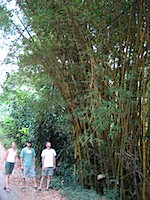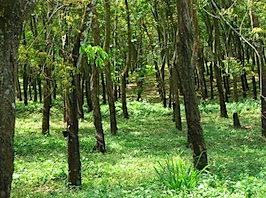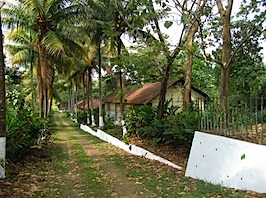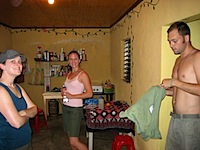
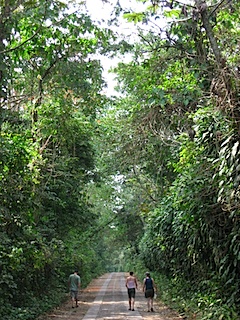 Whenever we travel, Emily and I try to make sure our path takes us through a town with friends. This means a free place to sleep, but more importantly, we get to see what other Peace Corps volunteers are doing. In the case of our friends Joe and Katy, we get the third benefit of shooting the breeze with people that we really like.
Whenever we travel, Emily and I try to make sure our path takes us through a town with friends. This means a free place to sleep, but more importantly, we get to see what other Peace Corps volunteers are doing. In the case of our friends Joe and Katy, we get the third benefit of shooting the breeze with people that we really like.
They just moved to a new site. That’s not normal; volunteers usually serve the same community their entire 2 years. The problem was, their previous site had been receiving aid from various international aid groups for about 10 years, and the site made unsuitable by “bad development work.” This happens when a well-intentioned charity group comes in with a lot of money and goodwill, but little time or experience, and accidentally does more harm than good. They give out latrines, stoves, etc. to the eager villagers, but don’t train them in the importance of the technology, how to maintain it, or why it’s even there in the first place. After a few years, the latrine starts to smell (not adding ash, or plugged vent) and the stove starts to smoke (not cleaning the chimney). Before long, the villagers revert to how they used to do things: pooping in the fields, making a fire on the floor. Those expensive latrines become chicken coops, and the stoves sit cold and serve as a dining room table. But the worst part? Not only are the people back where they sarted, but when a group like Peace Corps comes along with our message of education, they aren’t interested. “How come you guys don’t give us stuff? Why should we waste our time listening to your talks?” The natives have already reverted to a welfare state.
That, in a nutshell, is “bad development work.” We fight it a lot, and even the big names in charity are guilty: here’s an example. To apply for a grant from Habitat for Humanity, one has a MUCH better changce of getting it if they can read and write (to fill out the forms, or to even know that Habitat exists in the first place). As a result, the people that get these houses are already in the top half of the economic stratus. That being the case, these houses often are built for a future son-in-law or some other absent person, as a sort of “savings plan” for the family. In villages such as these, there is often a housing shortage as well. The new Habitat house stands empty, as the family is “saving” it for the future son-in-law. It’s about then that the Peace Corps places a volunteer in town, and BAM! suddenly you have a meeting between the only person in town that earns enough cash to pay rent, and the only family in town that owns a vacant space. So, in effect, Habitat builds houses for Peace Corps volunteers. Joe and Katy’s old site even has one of these cases right now.
But, back to their new site. In case the title didn’t give it away, they live in the jungle. As our bus made the multi-hour trip down from Xela, I noticed it getting pregressively more hot and humid as we continued our descent. Theirs is REALLY different than our site; in fact, it reminds me a little of Virginia in August: bug noises, wildlife abounding, palpable humidity, and heat that makes you just want to lie around all day. Katy was quick to point out that this is the cool, dry season for them… I shudder to think of the misery involved with the “hot” season. But they’re from southern California, so they’re used to it. Maybe they even like it?
Of course, when you go to the jungle, you have to check out the crazy plants. Here we are posing next to some huge bamboo plants, followed by a plantation of rubber trees (if you click and enlarge the picture, you can see the taps and rubber reservoirs). Also, the jungle area of Guatemala (which is most of it, by the way) has long been the stronghold of coffee and fruit fincas, or plantations. We passed a few as we walked with them to an outlying village. Joe says that most of their villagers work on these fincas, and although conditions have improved since the first half of the 20th century (when United Fruit Company forced the natives into slave labor), the living conditions of these workers can still be considered “squalid” by most standards.
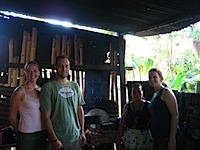
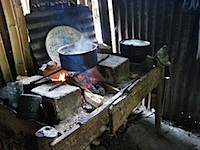 At their aldea, J&K introduced us to a midwife they’re working with. She was an energetic, peppy lady; I could hardly believe she was in her 60s. She proudly claimed to have presided over more than 300 births, though we didn’t ask what her win/loss ratio was. J&K are planning on building her a stove, to drum up community interest for some development projects. She showed us her current kitchen, which was pretty standard fare for Guatemala. I’ve enclosed a picture.
At their aldea, J&K introduced us to a midwife they’re working with. She was an energetic, peppy lady; I could hardly believe she was in her 60s. She proudly claimed to have presided over more than 300 births, though we didn’t ask what her win/loss ratio was. J&K are planning on building her a stove, to drum up community interest for some development projects. She showed us her current kitchen, which was pretty standard fare for Guatemala. I’ve enclosed a picture.
